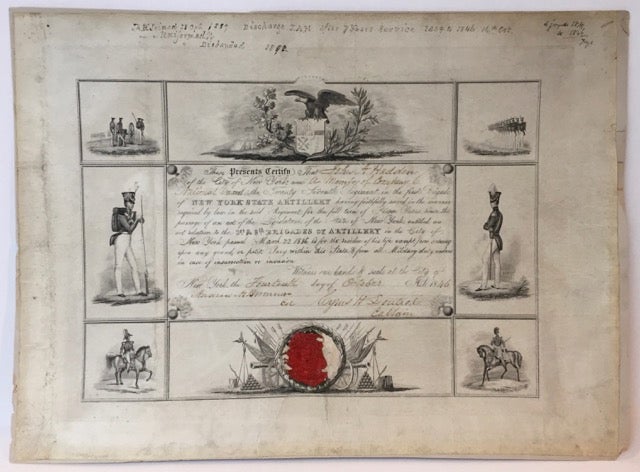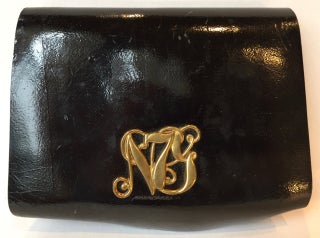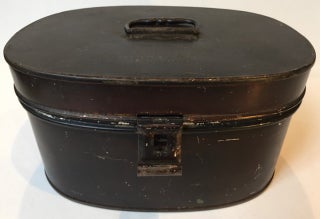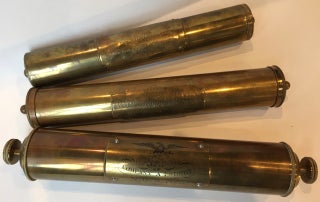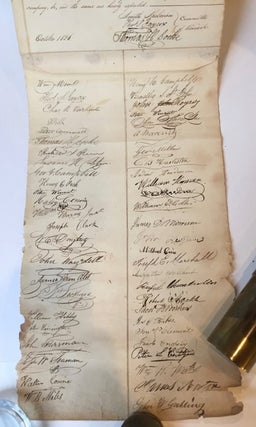CORE HISTORICAL DOCUMENTS AND MEMORABILIA FROM THE FIRST COMPANY, 7TH REGIMENT NATIONAL GUARDS, NEW YORK STATE ARTILLERY, New York City, ca. 1816-1847.
A collection of 11 items from the first organizational years of the National Guard unit which protected New York City in the early 19th century. The group consists of three brass cylinders, each containing rolled manuscript documents related to the regiment; an oval metal box containing a pair of epaulettes from the 7th; a wallet style polished black leather military bag, with a gilt emblem of the 7th National Guards on the front flap; and a partially printed document, completed in manuscript, acknowledging the service of a member of the regiment. New York, 1816-1847. What became known as New York's Seventh Regiment was originally organized in April, 1806, as a response to the threats from the British search and seizure policies in New York harbor. The regiment consisted of four companies, comprising many of the merchants and tradesmen in the city. During the War of 1812 the unit, by then designated the 2nd Battalion 11th Artillery, manned the guns of the forts guarding New York harbor. After the war, a military-weary New York saw a fall-off of interest in drilling and training by militias. The appointment, in 1820, of Col. James Benedict to lead the Eleventh, brought a renewed interest in organized training, discipline, and field exercises, attention to uniforms and equipment, and regular attendance at meetings. His order regarding the wearing of pantaloons over boots is reflected in one of the documents present here. By 1824, the Eleventh had been renamed "The National Guards" in honor of the Marquis de Lafayette, and by 1826, it was redesignated "The Twenty-Seventh Regiment of the New York State Artillery." In addition to official parades, and escorting of dignitaries, the national Guards were used to maintain order in the city during public executions in the 1820s, and were called out to help quell riots in the 1830s. A reorganization of all the militia units resulted in its new official designation as the Seventh Regiment in 1847. All of the material is in very good condition (aside from some scuffing to the metal box). Each of the brass cylinders has an engraved label and the end of each one unscrews to reveal the rolled document inside. The metal box has a faint blind-stamp on the lid identifying it as having been produced by J.H. McLenney & Co., 141 Grand St., New York. The leather wallet is stamped in blind on the back "Ridabock & Co., New York." McKenney & Co., and its successor Ridabock & Co. were manufacturers and dealers in military goods. (#6445). Item #58705
Itemized list of the collection: (a) The first cylinder, engraved label reading "Roll of Honorary Members, 1st Co., 7th Regt." The document inside, dated June 23, 1816 (206 x 25 cm., consisting of 6 pages tipped together, end-to-end) records the "Bye laws for the Regulation of Capt. James Benedict's Company in the Eleventh Regiment NY State Artillery," including the establishment of a monthly meeting time, regulations regarding attendance, new members, arms & equipment, etc. It is signed by the three members of the Committee of Revisal, Gilbert Hopkins, Irad Hawley, and Richard E. Purdy, as well as approximately 77 members of the company. Damage to the lower corner of the document has resulted in the loss of several signatures; some chipping along the right margin of the scroll, occasionally affecting a word or two. (b) The second cylinder, engraved label reading "Roll of Company. 7th Regt. N.G.S.N.Y." Rolled inside are two separate documents. The first, dated May 18, 1821 (90 x 20 cm., consisting of 3 pages tipped together, end-to-end) is a document signed by the members of the company commanded by Capt. Gilbert Hopkins, 11th Regt, 1st Brigade, pledging to abide by a decision regarding the wearing of pantaloons over instead of under Boots on Parade (signed by 67 members of the company). The second document is undated (22 x 20 cm., a single leaf) approves an alteration to the by-laws regarding dunning members for non-attendance, signed by 20 members. (c) The third cylinder, engraved label reading "Roll of the first Company National Guards, New York State Artillery" (ownership name partially rubbed out, but research shows it reads "Captain J.S. Cocks"). The manuscript document records another revision of the by-laws, this one from October, 1826. Printed in block letters at the head of the document (184 x 23 cm., consisting of 5 pages tipped together, end-to-end) is the title "TWENTY-SEVENTH REGIMENT / NEW YORK STATE ARTILLERY / PRO PATRIA ET GLORIA / NATIONAL GUARDS." The text includes several modifications to various articles of the by-laws, and is signed by the members of the Committee of Revisal, Smith Spelman, Thos. Jaycox, and Thos. H. Locke, along with 48 other members of the regiment. Some chipping to the margins of the document, not affecting text; one long tear, carefully repaired on verso, touching some letters, but all still legible. The ink from the block lettering has burned through the paper in spots. John Samuel Cocks (1813-1868), whose name is etched on the cylinder, was elected captain of the First Company of the 7th Regiment in 1838, and resigned in 1845. During the Civil War he served as a Colonel with the 40th New York Infantry, Mozart Regiment. A Successful New York businessman and member of the New York state legislature, he died in Brooklyn in 1868. (d) The black metal box containing the epaulettes is moderately scuffed. There is a small metal handle on the lid and a clasp. The epaulettes rest on an oval post mounted inside the box. Each is braided, and has a brass crescent on the shoulder (dulled) and a round emblem of red cloth with a contrasting black & gray striped cloth "7" affixed to it, a gold button embossed with an eagle, and two bars. The epaulettes show some wear, particularly on the undersides (where a metal plate denotes left and right shoulder pad), with modest fraying to the edges. (e) The leather wallet has high polish; the ornamental lettering "NG7" on the front flap is bright, the small leather loop clasp is worn, but intact. (f) A partially printed document (image size, 21 x 31 cm., on a larger sheet, 30 x 40 cm.), completed in manuscript, and dated October 14, 1846. The text is surrounded by eight vignette illustrations, six of men in uniform, on horseback, in ranks, one of an eagle perched on a shield, and the last of swords and cannons, with a red wax seal over the middle (partially chipped away). The document acknowledges the seven years service of John A. Hadden, in Company 6, National Guard, 27th Regiment, and declares him to be exempt, for the rest of his life, from both jury service and further military service. Signed by two members of the regiment, Andrew H. Brenner and Cyrus H. Loutrel. A few creases in the surface of the document which is a little soiled, and has some later ink notes by Hadden in the upper margin.
Price: $4,500.00

